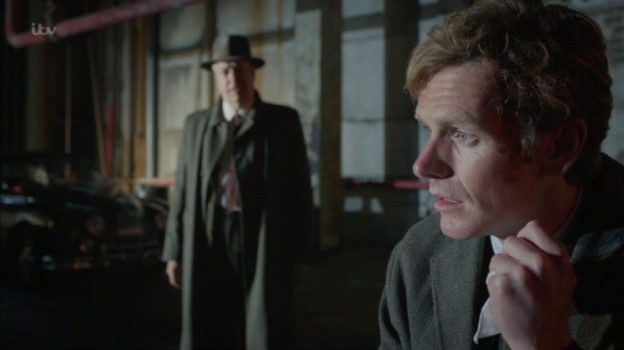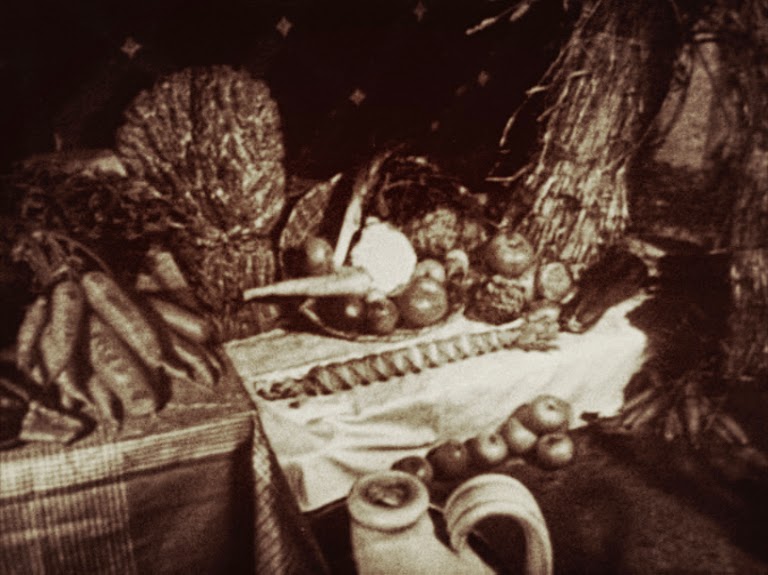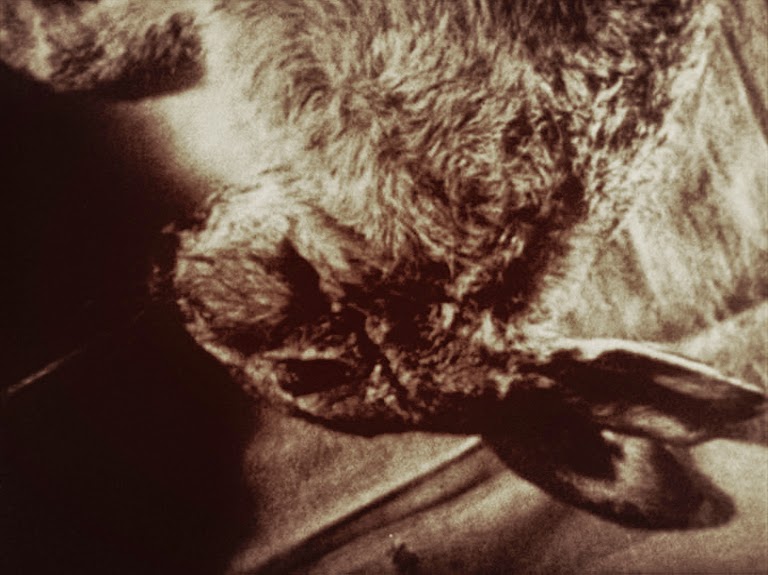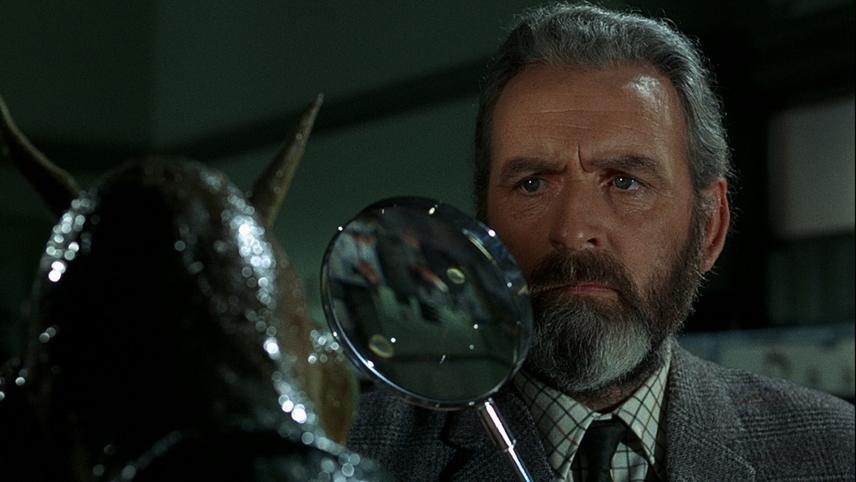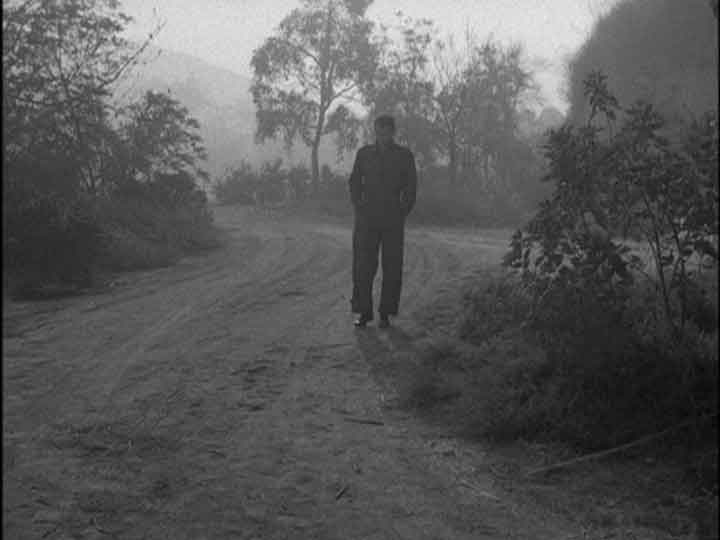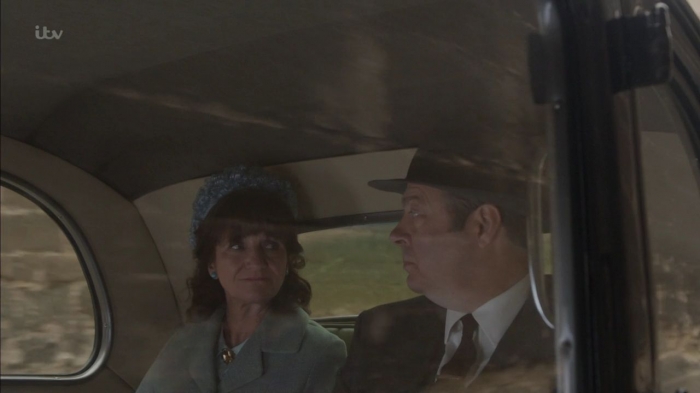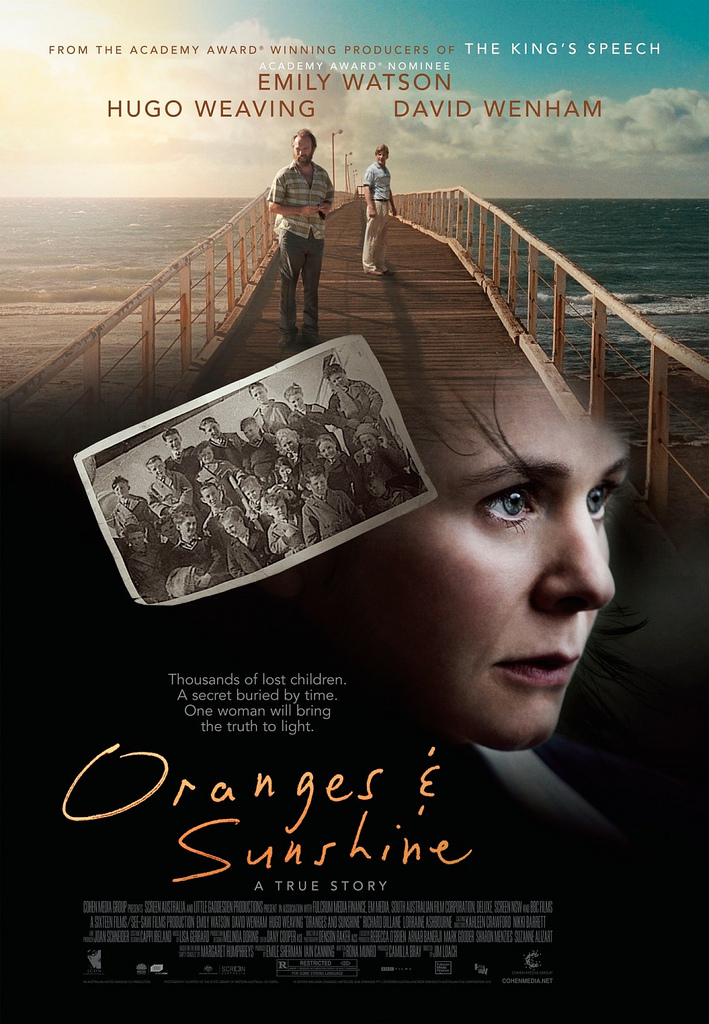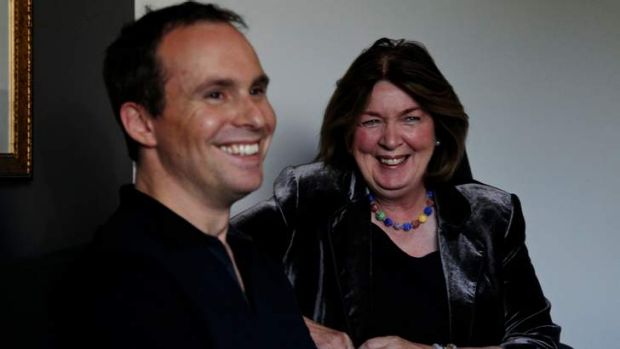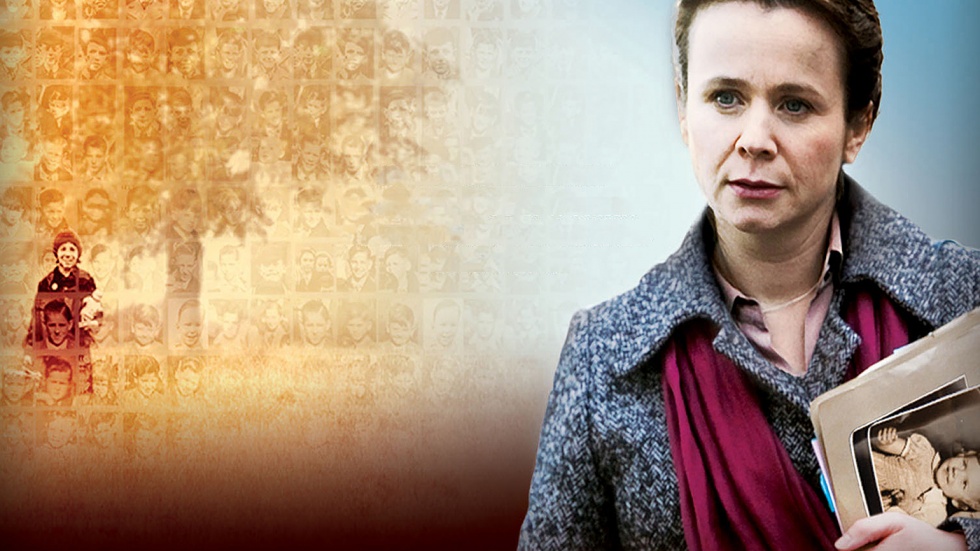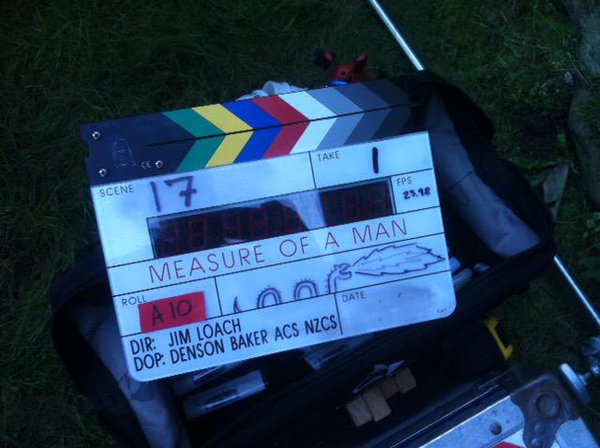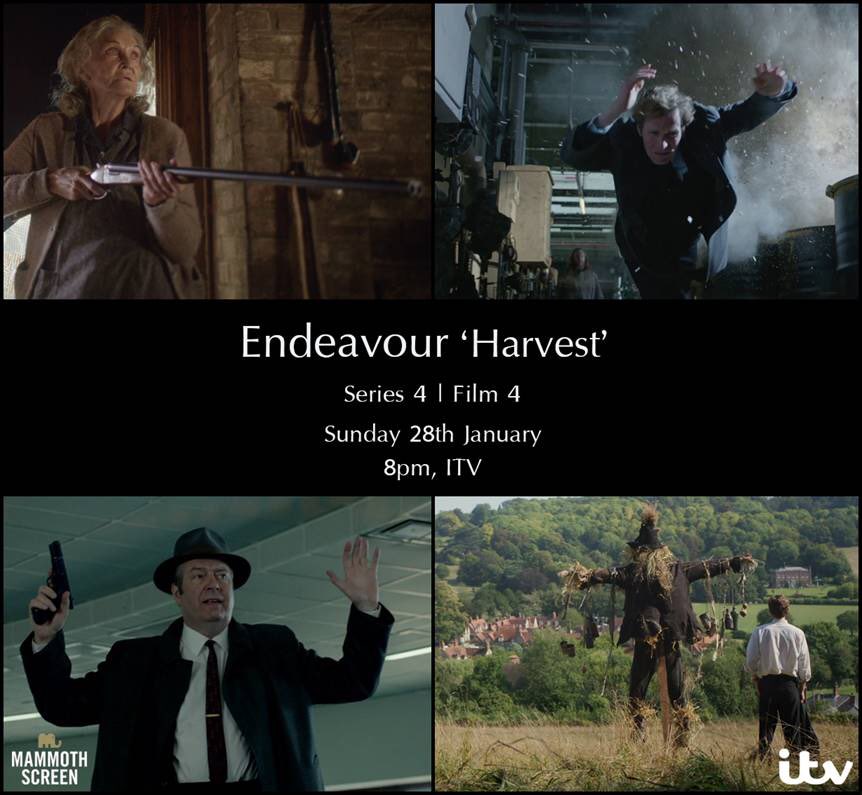EXT. WOODS/GINGERBREAD HOUSE – DAY 1
Late afternoon. ENDEAVOUR makes his way through the woods. At last, he reaches, an ancient dwelling that seems to have grown out of the earth itself. Mossy. ENDEAVOUR comes to the door. A raggedy broomstick leant against the wall. ENDEAVOUR knocks.
ENDEAVOUR: Hello? Miss Chattox?
ENDEAVOUR pushes open the door. Darkness…
ENDEAVOUR (cont’d): Good afternoon. My name is…
ENDEAVOUR reacts to something out of view — backs away.
The business end of a single barrel SHOTGUN emerges from the gloom…
 DOWSABLE (O.S.): Morse. That’s your name, isn’t it?
DOWSABLE (O.S.): Morse. That’s your name, isn’t it?
… the weapon held steadily in the hands of the formidable DOWSABLE CHATTOX, (80s).
DOWSABLE (cont’d): Morse. I’ve been expecting you.
– HARVEST (P.35 Readthrough Draft)
THE OTHER PLACE
Exclusive ENDEAVOUR interview
With Russell Lewis
Interview copyright © Damian Michael Barcroft 2018
~~~
With thanks to Rosemary Woodhouse
~
DAMIAN: And I’ve been expecting you Mr… Lewis. Way through the woods indeed! Anyway, who had the wonderful idea to cast Sheila Hancock?
RUSS: It’s been a twinkle in our eye for some time. But the 30th Anniversary seemed to be the right time. It probably took us that long to pluck up our nerve.
 DAMIAN: Did you meet her at any point?
DAMIAN: Did you meet her at any point?
RUSS: I’ve met her before – but not during the shoot.
DAMIAN: Chattox? A nod to the Pendle Witch trials?
RUSS: Indeed.
EXT. BRAMFORD MERE
DOROTHEA: Good morning, Miss Chattox. Dorothea Frazil. Oxford Mail. I interviewed you a few years ago, about your battle with the Power Station.
DOWSABLE: I remember you.
DOROTHEA: Still fighting the good fight, I see.
DOWSABLE: If you mean they haven’t seen me off yet, then, no – they haven’t. Nor will they.
DAMIAN: Please tell me this scene was actually filmed and still exists somewhere?
RUSS: I’m not sure it was shot. There was a lot of what the eye doesn’t see, the heart doesn’t grieve over on this one. I think I only became aware of what hadn’t been shot after the event. Our time with Sheila was quite contained – and this may have been a casualty of the schedule.
DAMIAN: I found HARVEST to be a game of two halves; the latter had something of The China Syndrome about it but it was the former element that I was particularly taken with involving Morris Men and their Horse and Fool which evoked films such as The Wicker Man. We’ve spoken more generally about the horror genre before but what specific influences from what we now term “Rural” or “Folk” Horror might we see in HARVEST that contributed to that strange and yet curiously British and creepy atmosphere?
RUSS: Well – obviously – as you’ve identified – The Wicker Man.
But also Robin Redbreast and a bit of Nigel Kneale’s Beasts. There were a couple of Brian Clemens’ Thriller that played with that ‘something nasty in the woodshed’, thing. One that featured an old family friend John (Juan) Moreno – who you’ll probably know best as Bond’s contact, Luigi Ferrara, in For Your Eyes Only. Cloven hoofs a go-go.
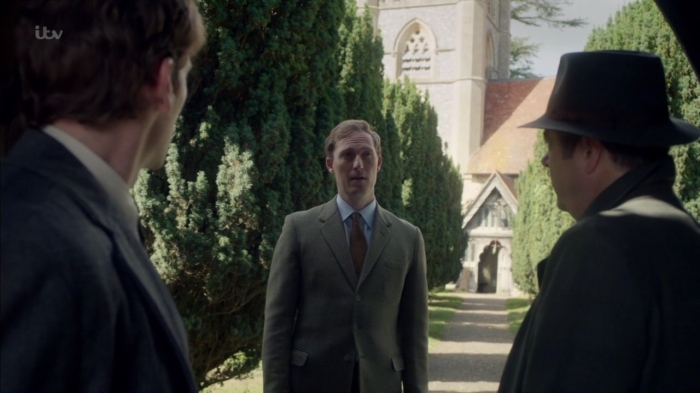 DAMIAN: Also possibly relevant to HARVEST, to what extent would you agree that Professor Bernard Quatermass is the single most important and influential character in British Science Fiction?
DAMIAN: Also possibly relevant to HARVEST, to what extent would you agree that Professor Bernard Quatermass is the single most important and influential character in British Science Fiction?
RUSS: Did he pave the way for a certain Gallifreyan? Quite possibly. The TV Quatermass casts a massive shadow – but most of it even before my time. Quatermass and the Pit is a classic — but until the Euston Films/John MIlls version – what was that? ‘79-ish? – he was more a character one got second-hand from memories of the previous generation.
DAMIAN: Many great actors have played Quatermass over the years but who would you say gave the definitive screen performance?
RUSS: I liked Andre Morrell, but probably Andrew Keir — the TV and film incarnations in Pit — which is probably my favourite story.
INT. THURSDAY HOUSE. HALL/LIVING ROOM – NIGHT 1
Onscreen – black and white: a rangey Dennis Hopper-alike, at the wheel of an open top car on a lost highway. Poor Man’s Process with much over-steering of the wheel.
NARRATOR (V.O.): Meet Edwin Brewster, age thirty-five. Occupation, drifter. A nobody from nowhere, about to make an unscheduled stop in a town not found on any map.
WIN watches TV — not taking it in.
NARRATOR (V.O.): For he has entered a dimension that lies somewhere between sleep and waking. Dream and nightmare. Life and death. It’s a region we call, ‘The Other Place.’
Opening sig for ‘The Other Place’ – theramin and surf guitar.
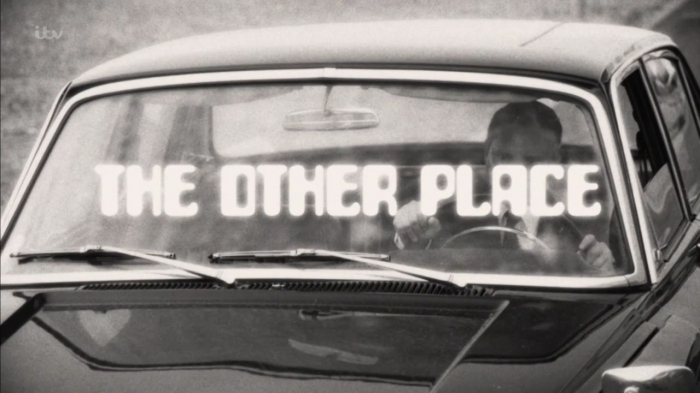 DAMIAN: You could have made up any TV show and yet you chose something reminiscent of The Twilight Zone or The Outer Limits. Why?
DAMIAN: You could have made up any TV show and yet you chose something reminiscent of The Twilight Zone or The Outer Limits. Why?
RUSS: It seemed fun to do. And played into the overall theme. Originally – the American couple were a nod to a particular Ira Levin novel that came out in ‘67.
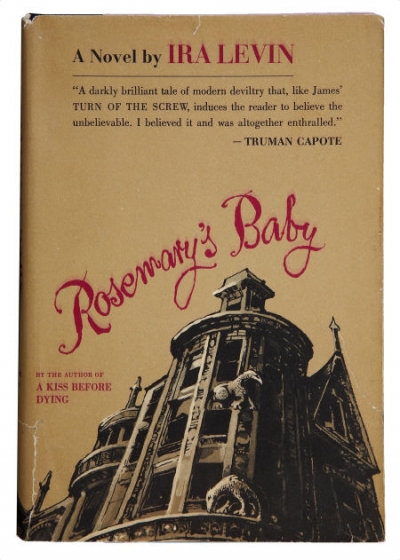 I think there was more material to do with them trying for a baby… So between them, and the paganism — we were setting up a blind to what was really going on. The Other Place thing was just underlining that deceit. But – yes, it was our salute to Rod Serling – who casts a giant shadow.
I think there was more material to do with them trying for a baby… So between them, and the paganism — we were setting up a blind to what was really going on. The Other Place thing was just underlining that deceit. But – yes, it was our salute to Rod Serling – who casts a giant shadow.
 DAMIAN: What’s your all-time favourite episode of The Twilight Zone or The Outer Limits?
DAMIAN: What’s your all-time favourite episode of The Twilight Zone or The Outer Limits?
RUSS: Too many to choose from. I like deserted town stories – so Where Is Everybody? – the Pilot, I believe – would have to be up there. And Stopover in a Quiet Town also falls into that category.
 Much of The Avengers has a similar vibe. A lack of Supporting Artists in the background lends everything a slightly surreal and dreamlike quality. How much of that was a budget call which dictated a creative decision, I don’t know — but in my memory at least – it seems very much a part of the the show’s DNA.
Much of The Avengers has a similar vibe. A lack of Supporting Artists in the background lends everything a slightly surreal and dreamlike quality. How much of that was a budget call which dictated a creative decision, I don’t know — but in my memory at least – it seems very much a part of the the show’s DNA.

 E/I. ENDEAVOUR’S FLAT. BASEMENT – DAY 3
E/I. ENDEAVOUR’S FLAT. BASEMENT – DAY 3
ENDEAVOUR is fingerprinted. SCENE of CRIME dusting for prints. TREWLOVE, back in uniform, fingers along ENDEAVOUR’s mantel — finds the photograph of ENDEAVOUR as a boy with his mother.
STRANGE: Little toerags. Sorry, matey.
ENDEAVOUR: One of those things. We see enough of it.
STRANGE: Yeh, but you’re one of our own. What d’they nick?
ENDEAVOUR: Radio. Record player. My signed Rosalind Calloway LP. Beside that there was nothing worth taking.
STRANGE: Why they smashed the place up.
Amongst the wreckage — STRANGE spies, the JAMES LAST LP he bought for ENDEAVOUR as a house warming present. He picks it up, slips the LP out of its slipcase. Vinyl intact. STRANGE exhales — relieved.
STRANGE: Least this one made it.
ENDEAVOUR: Small mercies.
 DAMIAN: While Lewis was obviously mischievously joking when he asked Morse in the original series if the piece of classical music he was playing in the car was Andrew Lloyd Webber (a beautifully played moment), Strange is completely genuine and oblivious with regards to James Last and isn’t it fantastic moments like these that economically sum up almost all we need to know about him and his polar opposite relationship with Endeavour?
DAMIAN: While Lewis was obviously mischievously joking when he asked Morse in the original series if the piece of classical music he was playing in the car was Andrew Lloyd Webber (a beautifully played moment), Strange is completely genuine and oblivious with regards to James Last and isn’t it fantastic moments like these that economically sum up almost all we need to know about him and his polar opposite relationship with Endeavour?
RUSS: I suspect their differences are why they get on – in their fashion. Strange makes much more of an effort with their friendship than Endeavour. He’s clearly fond of him – and there’s admiration too, for his abilities. A thoroughly decent cove is old Strange. And the one man you’d want to see coming round the corner if you were ever in a tight pinch.
DAMIAN: If someone asked me if Endeavour would have a picture of his mother I would have, obviously incorrectly, said absolutely not. And yet, there it is in his flat following the burglary, a photograph of Endeavour as a boy with Constance. I thought Endeavour was almost in denial about his past so why would he want to have this sitting in a frame on his mantlepiece?
RUSS: I think it was put there as it was something he recovered from the wreckage and didn’t want to lose. The plan would have been to put it away again once he’d got the place straight. As you say – it’s something that would have been laid up. Out of sight, out of mind. Sometimes we reach to the back of a darkened drawer only to catch our fingers on a forgotten knife.
DAMIAN: Of the many scenes that never made it to the final cut, was it particularly painful to lose Sam’s return home which obviously resulted in him not appearing in the entire fourth series?
RUSS: Yes. We all love Jack B., and miss him around the homestead. But story is always king — and the plan had always been to reflect the changing times by way of the Thursdays changing family circumstances.
DAMIAN: Not that she isn’t genuinely sorry and traumatised, but was there ever a sense for you as a writer, or perhaps between Shaun and Sara in playing the scene, that Joan was using the Wessex Bank robbery and the death of Ronnie Gidderton as an excuse to leave Oxford and escape the conventions and expectations of an almost predetermined life that she’s only half in love with?
RUSS: Mmm. I’m probably a bit more inclined to take her at face value. I don’t think anyone realised quite how deeply Ronnie’s death affected her. She held herself utterly to blame. It was too much for her. She had to get away – but I think the self-imposed exile was also her punishing herself.
 EXT. OXFORD – DAY
EXT. OXFORD – DAY
WIN and SAM on their day out.
WIN: Well, that was nice.
SAM: So, what do you fancy for this after?
WIN: Oh, I don’t mind. You pick. I am glad you’re home, Sam.
SAM: I know.
WIN: I wouldn’t want you to think I wasn’t. Just… with everything.
SAM: She’ll come home. You’ll see. You know Joannie.
WIN: Stubborn. Like her father. You take more after me.
SAM: Well. Some of us have got to be sensible. Right?
SAM slips his arm through WIN’s and they tootle off…
DAMIAN: If Joan does indeed take after her father as is stated in this cut scene, does this perhaps foreshadow even more dark times and trouble ahead?
RUSS: I wouldn’t want to give anything away.
 DAMIAN: I thought when I first watched it that there was something about the production design that reminded me of early the Bond films and then there it was in the script when I read it; your description of the Bamford Goldenrod Reactor Building as ‘A Ken Adam fantasy of gantries and walkways towering high above the floor.’
DAMIAN: I thought when I first watched it that there was something about the production design that reminded me of early the Bond films and then there it was in the script when I read it; your description of the Bamford Goldenrod Reactor Building as ‘A Ken Adam fantasy of gantries and walkways towering high above the floor.’
 In addition to Fleming obviously, the cinematic Bond owes so much to people like John Barry (for the sound if not composition of the Bond theme – not to mention eleven glorious music scores), Peter Hunt (the innovative editing style and later direction of On Her Majesty’s Secret Service) and the fines tastes and style of director Terence Young. Visually speaking however, isn’t Ken Adam arguably one of the most significant contributors to the 007 series?
In addition to Fleming obviously, the cinematic Bond owes so much to people like John Barry (for the sound if not composition of the Bond theme – not to mention eleven glorious music scores), Peter Hunt (the innovative editing style and later direction of On Her Majesty’s Secret Service) and the fines tastes and style of director Terence Young. Visually speaking however, isn’t Ken Adam arguably one of the most significant contributors to the 007 series?
RUSS: Yes. Absolutely. He’s a bit of a touchstone for us — and gets another run out in this series.



 DAMIAN: We’ve touched on Bond many times, but remarkably, I don’t think I’ve ever asked you who your favourite Bond is…
DAMIAN: We’ve touched on Bond many times, but remarkably, I don’t think I’ve ever asked you who your favourite Bond is…
RUSS: Easier to pick a favourite Bond movie. Daniel Craig’s Casino Royale is the best of the modern era. Certainly my favourite of his to date. There’s been some great set pieces in the others – but, come on, Mads Mikkelsen for a villain, and Eva Green delivering arguably the most fully realised female character in the franchise. (Dame JD’s ‘M’ notwithstanding.) But – you know – it had pretty incomparable source material to drawn on. Consequently, it felt more faithful to Fleming’s original vision than anything for a long time.
And yet… It’s a dead heat for me with On Her Majesty’s Secret Service. With Lazenby’s sole outing maybe just edging it by a period nose. John Barry’s sublime score. Dame Diana Rigg. Telly Savalas turning in the best Blofeld of the classic period. (Apologies to Donald Pleasance). Ilse Steppat’s Irma Bunt. Gabriele Ferzetti. Piz Gloria. The set pieces – the various ski chases and bobsleigh sequence – are sensational. It’s just a first rate adventure/thriller that can be enjoyed on its own terms. I’m a sucker for snow.
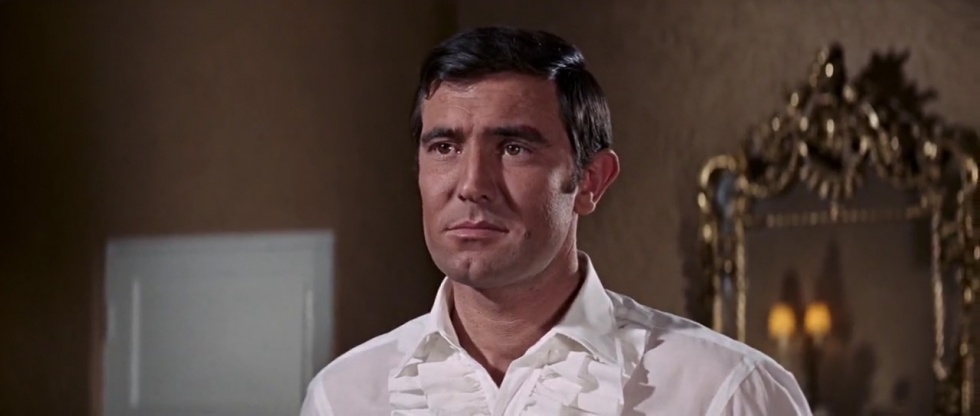
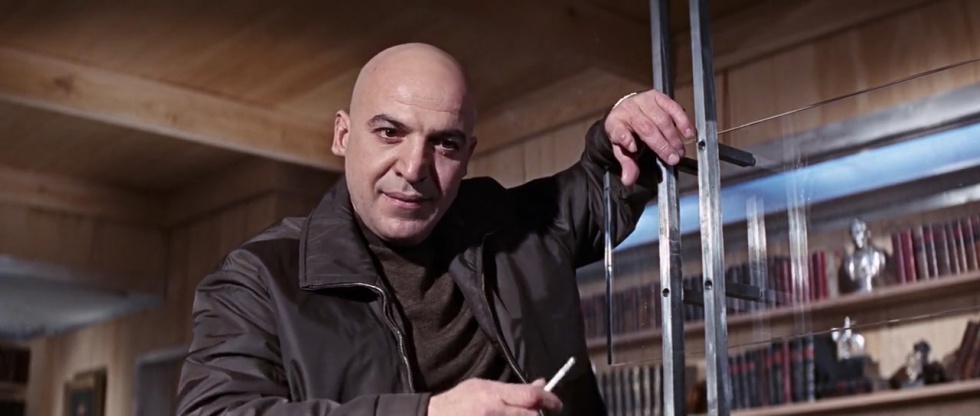
 The first three Connerys are pretty sacred. But it’s hard to escape the conclusion that Goldfinger’s blockbuster success set the template in concrete – which is a bit of a pity. Dr. No very much a period piece now. From Russia With Love is a great spy movie, and felt very much its own thing. After Goldfinger, you can pretty much follow the bouncing white dot at the bottom of the screen, knowing exactly how it’s going to unfurl. I’m sure there are exceptions to the rule, but a good number of them thereafter seem locked into the tramlines. The only place left to go is bigger. It starts to creep in with Thunderball, and by the time of You Only Live Twice it’s just massively overblown. Which is probably why OHMSS felt so refreshing – like the reset button had been hit.
The first three Connerys are pretty sacred. But it’s hard to escape the conclusion that Goldfinger’s blockbuster success set the template in concrete – which is a bit of a pity. Dr. No very much a period piece now. From Russia With Love is a great spy movie, and felt very much its own thing. After Goldfinger, you can pretty much follow the bouncing white dot at the bottom of the screen, knowing exactly how it’s going to unfurl. I’m sure there are exceptions to the rule, but a good number of them thereafter seem locked into the tramlines. The only place left to go is bigger. It starts to creep in with Thunderball, and by the time of You Only Live Twice it’s just massively overblown. Which is probably why OHMSS felt so refreshing – like the reset button had been hit.
The least said about Diamonds Are Forever the better. Great theme song – but otherwise very hard to love. There’s a sourness about it that leaves a nasty taste. Maybe it’s that much of the main section of the film has a Las Vegas setting. It’s suddenly vulgar – reeking of stale cigar smoke and a gambler’s desperation – in a way it never had been before. Bambi and Thumper. Plenty O’Toole. Eek… A sign of the changing times. Tricky Dickie in the Willard Whitehouse, and Watergate just around the corner…
I suppose Ernst Stavro Blofeldd had to be grafted on as the stories were shot out of sequence, and there had to be a pay-off for the ending of OHMSS, but I always preferred the fate of Dr. Shatterhand in the novel of You Only Live Twice.
I guess that’s one of the things I like so much about 007’s latest incarnation. He bleeds.
DAMIAN: I agree with regards to OHMSS which I personally believe to be the best and certainly the most stylish of the series. I’m a huge fan of Lazenby’s 007 and think he did an amazing job especially considering it was possibly one of the most difficult roles in cinema history to take on after Connery. However, for me, he’s in joint first place with another underrated Bond – the magnificent Timothy Dalton. Yeah, his two entries weren’t the best (although I greatly admired the grittiness of License to Kill) but he’s possibly the greatest actor to play Bond. And there’s just something about his look – those eyes – which is how I imagine Bond when I read the novels. Personally, I think they should leave the current franchise alone and simply adapt all of Fleming’s original stories almost word for word, set them in their proper period of the fifties and sixties and adopt the style of From Russia With Love. That said, Barbara Broccoli and Michael G. Wilson seem to be doing OK without my input.
Anyway, back to Endeavour and the power station, in the script Blake turns to find Endeavour ‘frozen to the stop — staring down between the latticed steps to the ground, floors below’:
BLAKE: Constable.
ENDEAVOUR: Heights. I can’t bloody move.
BLAKE: Vertigo, is it? Poor chap.
DOROTHEA comes across.
DOROTHEA: Just shut your eyes and take my hand. Come on. One foot in front of the other.
Freudian nightmares aside given the circumstances in which she was cast, am I completely wrong is suspecting that Dorothea is attracted to Endeavour – just a little bit?
RUSS: Hate to disappoint you, but I don’t think any of us look on their relationship that way.
 DAMIAN: You occasionally recycle scenes that don’t make the cut for future films so, and as much as I would love to because it’s quite a revelation of sorts, I won’t describe it in detail – let’s just call it the lime-juice and gin scene – please tell me you have plans to revisit it?
DAMIAN: You occasionally recycle scenes that don’t make the cut for future films so, and as much as I would love to because it’s quite a revelation of sorts, I won’t describe it in detail – let’s just call it the lime-juice and gin scene – please tell me you have plans to revisit it?
RUSS: Mmm. Yes. Most of these scenes we’re talking about are character moments — and they’re always the ones to suffer in the cut. I repurpose and redeploy some of them – not out of general indolence – but because they’re important, and shed a light on our heroes and heroines. Plots can change – but the characters still have the same baggage. And it’s nice to see some of that from time to time.
DAMIAN: What can you tell me about FILM 4: COLOURS?
RUSS: Not much. Part of its genesis was a news report that turned up in research – concerning a hairdressers in Oxford. It seemed to fit with our theme for ‘68. Turbulent times. Elsewise – there’s a collision of worlds.
DAMIAN: Russ, thank you very much indeed.
RUSS: You’re welcome.
~
BRIGHT: Oh – there was one more thing. I have this day received a letter…
[The following scenes appear as originally written in the readthrough draft intercut with those between Endeavour and Joan in hospital which are pretty much how we saw them in the broadcast version and so not included here]
EXT. THURSDAY HOUSE
THURSDAY at the kerb. TAXI there. WIN in the back seat.
WIN: Come on, Fred. We’ll be late.
THURSDAY: Just give him another five minutes.
SAM comes out of the house.
SAM: He [ENDEAVOUR] can’t make it.
THURSDAY: What d’you mean he can’t make it?
SAM: That was him on the phone. Something’s come up.
THURSDAY: I’ll give him ‘Something’s come up’ when I see him.
SAM: Go on. Good luck.
THURSDAY get in the TAXI, which pulls away. SAM watches after them…
A BLACK CAB drives up the MALL towards BUCKINGHAM PALACE.
BRIGHT (V.O.): I am instructed to inform you that Her Majesty The Queen has graciously approved the award of…
 INT. BUCKINGHAM PALACE. AUDIENCE CHAMBER
INT. BUCKINGHAM PALACE. AUDIENCE CHAMBER
A gloved hand pins the GEORGE MEDAL to THURSDAY’S breast.
BRIGHT (V.O.): …the George Medal to Her entirely well-beloved subject Detective Chief Inspector Frederick Albert Thursday for Special Services in Defence of the Realm…
THURSDAY and WIN outside the palace.
BRIGHT (V.O.): Given the circumstances details pertaining to the award will be neither cited in the Gazette, nor entered into the public record.
WIN inspects the medal.
WIN: ‘For Gallantry’. Get you.
THURSDAY: Fancy the pictures? As we’re here. There’s a Lee Marvin at the Gaumont.
WIN: War, is it?
THURSDAY: Pie n mash after, if you play your cards right. I might even let you take me home.
THURSDAY slips his arm through WIN’s and they head off.
 DAMIAN: Every week I’ve tested your patience by asking why such and such a scene was cut but again, this is even better than what we saw onscreen isn’t it?
DAMIAN: Every week I’ve tested your patience by asking why such and such a scene was cut but again, this is even better than what we saw onscreen isn’t it?
RUSS: What can I tell you? We’re always up against it for time. I think in this instance we did shoot this sequence — but it didn’t make the cut. I write them pretty much to length — and then there’ll be requests for additional material — something that’s not landing just so that needs help, or something that hasn’t been realised quite as well as we envisioned — and the original stuff gets squeezed out. Perhaps one day — when we get to the end — we’ll look at them again, and do definitive, unexpurgated cuts. Or at least package together all the out-takes – and moments that didn’t make it. You have to be careful though — the tone of something can change hugely in the edit. Structure too. And some of them wouldn’t bear the reintroduction of those excised scenes.
~
